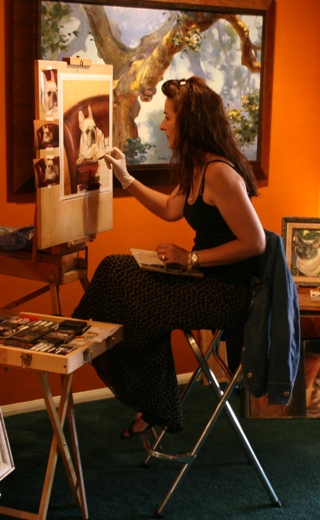Why do you sometimes paint in pastel instead of painting in oils?
This is a question I hear with some regularity.
Oil paintings in progress are not as easily transportable with me when I go on vacation or on the road to dog shows. Since pastel is a dry medium, it is a very easy medium to take with me when I am out of the studio and on the road so I can continue painting no matter where I am.
Pets are always in my studio because I use them constantly for "live models". I will look in the pets' eyes to see how a real life eye lid folds or at the nose and in the nostrils to get a better visual aid for my paintings. The pets provide me with a living example of hair direction. Be it a Labrador Retriever or an Irish Setter - for the most part, the hair lays in the same direction on the legs - the face, the neck etc. Sometimes the reference photos do not give me the detail I need of my subject to produce the quality of work that is important to me. When working on an oil painting, I have to lock the cats out of my studio...that is not necessarily a bad thing though!!! For the most part, my pets are always around me.
Pastel is pure pigment, the same pigment used in all art media. When properly framed, it is the most permanent of all when applied to archival ground. Pastel has no liquid binder that may cause the surface to darken, fade, yellow, crack or blister with time. No other medium has the power of color or stablity of pastel. It does not oxidize with the passage of time. I love to use my hands to move color around in the painting. Pastels allow me to do that in my paintings.
A particle of pastel pigment seen under a microscope looks like a diamond with many facets: therefore, pastel paintings reflect light like a prism. Pastel does not refer to pale colors, as the worid is commonly used in cosmetic and fashion terminology. The name "pastel" comes from the French word "pastiche," because the pure, powdered pigment is ground into a paste with a binder and then rolled int sticks. (Pastels have been referred to as chalk. The use of chalk predated the use of pastel as a medium. Manufactured pastels are vastly different from the dyes and binders characteristic of fabricated synthetic chalks.)
The presence of pastel has been identified in works of art from about 1500 AD. Leonardo, the most prominent proponent of this art form, is credited with the first known use of pastel in his portrait of Isabella D'Este (1499). A century later it was recorded that Leonardo practiced "a pastello".
Today, pastel paintings enjoy the stature of oil and watercolor as a major fine art medium. One of Degas' most fascinating pastels, "Au Musee Due Louvre (Miss Cassatt), " was sold at Sotheby's for $16.5 million. The Pastel Society of America.
These are just a few reasons I prefer to paint animal portraits in pastel over oils......HOWEVER......when it comes to painting landscapes outside, I love to break out my oil paint and brushes. So, I paint in both mediums now. The animal paintings are usually pastel and the landscapes / plein air paintings are usually in oil. Both mediums have their own special qualities and both have found a place in my heart.
Dawn Secord


